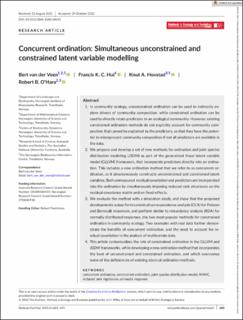| dc.contributor.author | van der Veen, Bert | |
| dc.contributor.author | Hui, Francis K. C. | |
| dc.contributor.author | Hovstad, Knut Anders | |
| dc.contributor.author | OHara, Robert Brian | |
| dc.date.accessioned | 2023-02-15T07:38:30Z | |
| dc.date.available | 2023-02-15T07:38:30Z | |
| dc.date.created | 2023-01-03T09:13:11Z | |
| dc.date.issued | 2022 | |
| dc.identifier.citation | Methods in Ecology and Evolution. 2022, 14 (2), 683-695. | en_US |
| dc.identifier.issn | 2041-210X | |
| dc.identifier.uri | https://hdl.handle.net/11250/3050891 | |
| dc.description.abstract | 1. In community ecology, unconstrained ordination can be used to indirectly explore drivers of community composition, while constrained ordination can be used to directly relate predictors to an ecological community. However, existing constrained ordination methods do not explicitly account for community composition that cannot be explained by the predictors, so that they have the potential to misrepresent community composition if not all predictors are available in the data. 2. We propose and develop a set of new methods for ordination and joint species distribution modelling (JSDM) as part of the generalized linear latent variable model (GLLVM) framework, that incorporate predictors directly into an ordination. This includes a new ordination method that we refer to as concurrent ordination, as it simultaneously constructs unconstrained and constrained latent variables. Both unmeasured residual covariation and predictors are incorporated into the ordination by simultaneously imposing reduced rank structures on the residual covariance matrix and on fixed-effects. 3. We evaluate the method with a simulation study, and show that the proposed developments outperform canonical correspondence analysis (CCA) for Poisson and Bernoulli responses, and perform similar to redundancy analysis (RDA) for normally distributed responses, the two most popular methods for constrained ordination in community ecology. Two examples with real data further demonstrate the benefits of concurrent ordination, and the need to account for residual covariation in the analysis of multivariate data. 4. This article contextualizes the role of constrained ordination in the GLLVM and JSDM frameworks, while developing a new ordination method that incorporates the best of unconstrained and constrained ordination, and which overcomes some of the deficiencies of existing classical ordination methods. | en_US |
| dc.description.abstract | Concurrent ordination: Simultaneous unconstrained and constrained latent variable modelling | en_US |
| dc.language.iso | eng | en_US |
| dc.publisher | John Wiley & Sons Ltd on behalf of British Ecological Society. | en_US |
| dc.rights | Navngivelse 4.0 Internasjonal | * |
| dc.rights.uri | http://creativecommons.org/licenses/by/4.0/deed.no | * |
| dc.title | Concurrent ordination: Simultaneous unconstrained and constrained latent variable modelling | en_US |
| dc.title.alternative | Concurrent ordination: Simultaneous unconstrained and constrained latent variable modelling | en_US |
| dc.type | Peer reviewed | en_US |
| dc.type | Journal article | en_US |
| dc.description.version | publishedVersion | en_US |
| dc.source.pagenumber | 683-695 | en_US |
| dc.source.volume | 14 | en_US |
| dc.source.journal | Methods in Ecology and Evolution | en_US |
| dc.source.issue | 2 | en_US |
| dc.identifier.doi | 10.1111/2041-210X.14035 | |
| dc.identifier.cristin | 2099299 | |
| dc.relation.project | Norges forskningsråd: 272408 | en_US |
| dc.relation.project | Norges forskningsråd: 223257 | en_US |
| cristin.ispublished | true | |
| cristin.fulltext | original | |
| cristin.qualitycode | 2 | |

